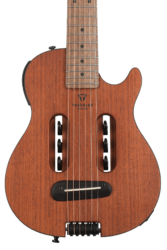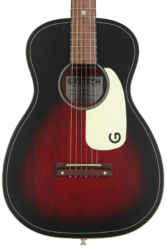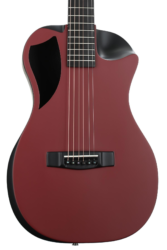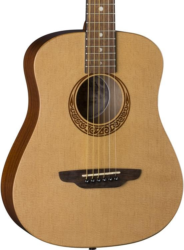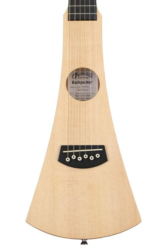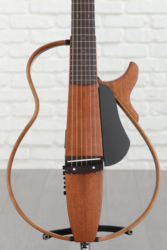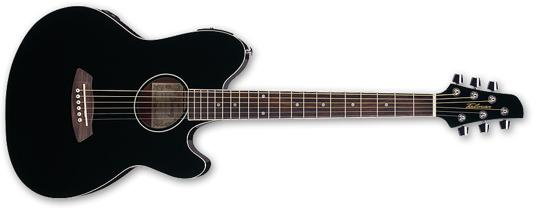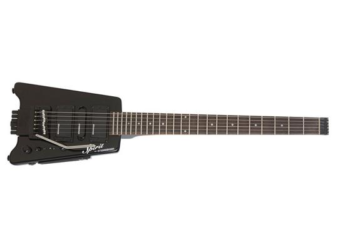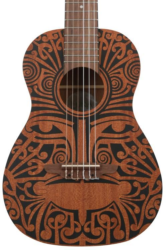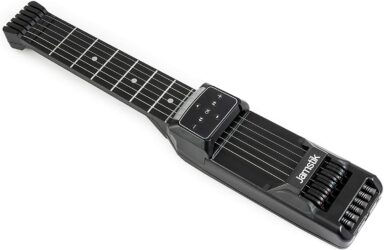We all have that friend that has to take their guitar with them on your annual camping trip. Undoubtedly, it’s some showpiece dreadnought, probably a Trigger clone, and it takes up more room than the entire beer cooler. Then you have to spend the entire drive (or worse, flight) paranoid that some cargo is going to shift and crush the thing. Maybe you are that friend.
Well, stop that. There’s a better way to bring your six-string with you. In this guide, we’ll look at 10 great guitars to travel with. First, we’ll break down what to look for, we’ll go in-depth after the reviews, and we’ll cap it all off with a little Q and A session.
- A Compact Guide to Compact Guitars
- Top 10 Best Travel Guitars 2025
- 1. Best Overall Travel Guitar: Traveler Guitar Escape Mark III
- 2. Best Budget Travel Guitar: Gretsch G9500 Jim Dandy
- 3. Best Premium Travel Guitar: Journey Instruments OF660M
- 4. Best ¾ Guitar: Luna Safari
- 5. Ultra-Compact Travel Acoustic: Martin Backpacker
- 6. Unique Lightweight Travel Guitar: Yamaha SLG200S
- 7. Great Travel Guitar for Gigs: Ibanez TCY10E
- 8. Best-Playing Electric Travel Guitar: Steinberger Spirit GT-Pro
- 9. Best Guitar Alternative: Luna Tribal 6-String Ukulele
- 10. Best Tech Toy: Jamstik Guitar Trainer
- FAQ
- A Closer Look at Travel Guitars
- Hit the Road
A Compact Guide to Compact Guitars
There is no set definition of a travel guitar; it’s simply a guitar that is easier to transport and carry around than your average guitar. That means there are hundreds of options to choose from, and they range in size from “fits in a messenger bag” to “a little bit smaller than a standard guitar.”
Don’t worry, we made this section to help you decide. Here are the things you should consider when you dive into the madness that is the world of travel guitars.
What Makes a Good Travel Guitar
Usually, you can choose a guitar that is ok, but not great, at all three properties of these properties. Otherwise, you can choose a guitar that makes sacrifices to be really good at one property.
Size
The smaller the guitar, the easier it is to travel with. That’s pretty straightforward. Just be aware that some guitars do tricky things like fold, which means that they can be full-sized but still easy to transport.
Playability
Travel guitars offer a huge range of playability options. Some guitars can be a little hard to play because the neck is too small, or the body is too uncomfortable.
Sound
A guitar has to sound good. That’s like, rule number one. In order to help you make sure you don’t end up with an instrument that you hate the sound of, we have both linked samples in our review, and we did our best to compare the sound to familiar things.
General Properties
The following four things are really just four things that you have to consider when buying any guitar. They just differ a little bit because you have to think of them in terms of how they affect travel.
- Type: Acoustic guitars are great because you don’t need an amp, but most smaller guitars are pretty quiet. Electric guitars need an amp. We have some good suggestions for a small amp here.
- Scale Length: Many modern travel guitars don’t sacrifice scale length, which is nice because that means they will feel like their non-travel counterparts. If you have smaller hands or just want the smallest instrument possible, though, there are plenty of short-scale options.
- Frets: You have to ask yourself, “Do I really need all 21-24 frets all the time?” Some guitars will sacrifice fret access to keep things compact, so if the answer is yes, that limits your options a bit.
- Material: Travel guitars tend to focus on the strength of the material rather than the pure acoustic properties. Sometimes that includes futuristic things like carbon fiber.
That’s about it for the quick guide. Really, what it comes down to is to use your intuition. You can look at a guitar and imagine what it feels like to play. You will know whether or not it meshes with your style.
Unless you are a total beginner, in which case get the Ibanez here. It’s the most normal guitar, it’s not very expensive, and it will grow with you rather than frustrate you.
Now that we’ve gone over the most important considerations when picking a travel guitar, let’s dive into the reviews of the best options on the market now.
Top 10 Best Travel Guitars 2025
1. Best Overall Travel Guitar: Traveler Guitar Escape Mark III
Why we like it:
It’s tiny, sounds great, has a full-size neck, and sounds ok without an amp. It’s everything you could ever want out of a travel guitar.
Quick Specs:
- Type:Acoustic-Electric
- Scale Length:25.5”
- Frets:22
- Material:Alder
- Sound Example: Youtube
Why It’s Good for Travel
Traveler Guitar is a company that, surprise, makes guitars meant for travel, and they are really good at it. Everything about this little ax is meant to make it easy to take with you. It’s only 30” long and a little under 11” wide at the widest point.
What really sets it apart as a travel instrument is that it’s really compact and light, but it remains really playable. Unlike many travel guitars, it has a full-sized Fender scale 22-fret neck with standard peg tuners. They are in the wrong spot, but they still function the same way.
How Does It Sound?
When you play it unplugged, it doesn’t sound amazing. It’s good for a little guitar–compared to the Martin Backpacker, the bass is amazing. But you will definitely notice that it lacks depth and warmth if you compare it to something like the Gretsch Jim Dandy.
The electronics are what really make it shine in the sound department. It sounds excellent plugged in. If you close your eyes and listen to the demo, you can’t tell the sound is coming from a guitar that is less than ⅓ the size of a dreadnought. The only downside to the electronics package is that there’s no ¼” jack, just a standard 1/8” for headphones.
One of the nice things about the Traveler Guitar is that if you would rather have a dedicated electric in the same style, they make them. They have the less expensive Ultralight, and they have what is frankly one of the best looking travel guitars you can get, the LTD EC-1.
Our Thoughts
Most of the time, choosing a guitar to travel with means choosing which sacrifices you are willing to make. The Escape makes very few sacrifices, and we love it because of that.
It feels great to play, it sounds great, and even though it doesn’t look traditional, it does look good with the white binding. There’s not much else to say about it. Unless you are looking for something particular out of a guitar, you’ll be very happy traveling with the Escape.
Pros
- Has full-sized neck and tuners
- Sounds great plugged in
- It is small enough to stuff in the overhead
Cons
- Not the best sounding unplugged
- Only has an ⅛” output
2. Best Budget Travel Guitar: Gretsch G9500 Jim Dandy
Why we like it:
The Jim Dandy is everything a traditional travel guitar should be. It’s small enough to take adventuring, is inexpensive enough that if you accidentally drop off a cliff you won’t have to lose too much sleep, and it looks fantastic.
Quick Specs:
- Type:Acoustic
- Scale Length:24
- Frets:18
- Material:Basswood
- Sound Example: Youtube
Why It’s Good for Travel
Parlor guitars are the original travel guitars. In fact, in the 1800s, they were the only guitars; those traveling musicians and original cowboys played this style of instrument. One was even shot into space for Chris Hadfield to play on the ISS. That’s a Larrivee P-01 for those of you playing the home game.
The Gretsch Jim Dandy has a big benefit over the Larrivee, though. It’s less than ⅓ the price. One of the hardest parts of traveling with an instrument is the paranoia over it getting damaged. The Jim Dandy is inexpensive enough that some of that paranoia is alleviated.
How Does It Sound?
You have to keep in mind that it is a budget parlor guitar, so don’t judge it as a vintage Martin dreadnought. If you need beautiful, clear sounds from a travel instrument, you should jump to the very expensive OF660M.
It does sound really competent, though. You get a good amount of midrange, but it doesn’t have the banjo levels of brightness that many small guitars suffer from. The tone is perfect for your backyard blues.
Our Thoughts
The Jim Dandy has an interesting history. It looks like an ancient design, and it would fit right into any collection of 20s instruments, but the line was actually introduced in 2015 as parlor guitars started to grow in popularity due in part to the fact that a guy played one in space.
What Gretsch came up with to capitalize on that popularity was to create a guitar that looks really fantastic, sounds decent, and doesn’t cost much. It suffers from the same drawbacks that most inexpensive guitars suffer from, like a lack of quality tonewood and budget tuners. Those aren’t dealbreakers, though.
What you may find yourself wanting is more fret access. However, it is a full-width neck. It’s more comfortable to play if you have bigger hands than a 3/4 guitar like the Luna.
Pros
- Inexpensive
- Has a decent tone for the price
- Looks great
Cons
- Higher frets are hard to reach
- Tuners could be better
Why we like it:
The OF660M is a no-compromises, absolutely stunning carbon-fiber instrument that sounds amazing and folds in half for easy transportation.
Quick Specs:
- Type:Acoustic-Electric
- Scale Length:24.5”
- Frets:20
- Material:Carbon Fiber
- Sound Example:Youtube
Why It’s Good for Travel
Let’s start with the biggest reason: the neck comes off. You undo a bolt in the back, press a button, and the whole guitar folds in half.
That’s not all there is to it, though. The entire instrument is carbon fiber. When you travel, there are a lot of risks to your guitar. Dry heat can warp the neck, inattentive airport people can kick your case as they walk by, or worse. Carbon fiber isn’t affected by temperature or humidity, and it’s nearly indestructible.
How Does It Sound?
It sounds great. We feel confident in saying that the OF660M is the best sounding acoustic instrument on our list.
It does have onboard electronics if you want to amplify it, but that’s not really where it shines. If you are just going to plug in the instrument all the time, the Traveler Guitar is also really portable and sounds fine when run through a speaker. Nothing compares to the unplugged sound of the OF660M.
Our Thoughts
As you can probably imagine, there is nothing cheap about this guitar. It is the most expensive instrument on our list. It’s also a little funky. The 24.5” scale takes some getting used too, and some people might find the body design awkward.
It’s such a fantastic guitar, though. The carbon fiber can be molded in ways that wood could only dream of, and Journey Instruments used that technology to create a travel guitar that doesn’t sacrifice tone.
Pros
- Folds in half
- Sounds amazing
- Nearly indestructible
Cons
- Very expensive
- The shape takes a little getting used to
4. Best ¾ Guitar: Luna Safari
Why we like it:
This ¾ size guitar looks stunning and plays great. Anyone that is into traditional campfire aesthetics will love it.
Quick Specs:
- Type:Acoustic
- Scale Length:22.5”
- Frets:19
- Material:Spruce
- Sound Example:Youtube
Why It’s Good for Travel
A ¾ guitar is a little bit different than a parlor guitar like the Gretsch we mentioned before. It’s still a small guitar, but where a parlor guitar has a full-size neck and a small body, a ¾ guitar has a neck that is ¾ size as well as a small body.
That makes them perfect for two types of people. The first category of people are people with smaller hands, like children. The neck isn’t as thick, and the space between frets is shorter than a full-size guitar, which means playing chords requires a lot less finger span.
The second type of people are the type that brings a guitar with them wherever they go. The small size really lends itself well to being thrown on top of the sleeping back when you load the car to go on a camping trip.
How Does It Sound?
Luna always surprises us with how good their smaller instruments sound for the price. Travel guitars will always lack the depth and volume that a full-size guitar has, but with the Safari, you get about as much bass as is possible from a small guitar.
The easy comparison to make is to the Gretsch Jim Dandy. The Gretsch is brighter and more bluesy. The Luna is softer and lends itself much better to an Ed Sheeran cover.
Our Thoughts
Luna always makes great looking guitars. The Peace has a unique cutout and designs burned into the top, but if you are daring, take a look at the Starry Night.
We admit that the design isn’t for everyone. The short scale and tiny neck can also turn your hands into pretzels if you are used to Fender’s necks. If that’s a concern, get the Jim Dandy or the Backpacker instead. If you have smaller hands or just want a really fun guitar to take adventuring, then you’ll love this Luna.
Pros
- Looks great
- Perfect for smaller hands
- Sounds bigger than it is
Cons
- Small size can make it difficult to play
- Looks can be polarizing
5. Ultra-Compact Travel Acoustic: Martin Backpacker
Why we like it:
Martin is one of the most celebrated names in the guitar world, and the Backpacker is synonymous with travel guitar. We are basically obligated to love it.
Quick Specs:
- Type:Acoustic
- Scale Length:24”
- Frets:15
- Material:Spruce
- Sound Example:Youtube
Why It’s Good for Travel
You only have to glance at it to understand why it’s good for travel. It’s a full-size neck attached to ¼ of a body. It fits in this tiny little soft case that has a shoulder strap, and it’s called the backpacker because it will fit in a backpack.
How Does It Sound?
It sounds shallow, it lacks bass, and it has almost no volume. That’s the sacrifice you make to get a guitar that is this small. Companies like Traveler Guitar work around that limit by adding robust electronics or really clever design elements.
Martin is different, though. They have a reputation to protect, and they are not known for leaning into gimmicks or gadgets. Instead, they decided that if they have a bright instrument without any reverb, they will make it a great sounding instrument that’s bright and has little reverb. It’s a really unique tone, kind of like a guitar-mandolin hybrid. It’s not for everyone, but it has its own beauty.
Our Thoughts
You can’t talk about travel guitars without talking about the Martin Backpacker. They are surprisingly affordable, play great, and easy to take with you anywhere.
Unfortunately, even though it is iconic, that doesn’t mean it’s the perfect guitar for everyone. A lot of modern guitars, like the Traveler Guitar, surpass it in functionality.
What the Backpacker excels at is being playable, though. The full-size neck and Martin quality control make it an absolute dream to sit down with. Also, there’s nothing wrong with wanting something because it’s a classic and prestigious instrument.
Pros
- Iconic
- Inexpensive
- Very easy to play
Cons
- The sound isn’t for everyone
- Not very versatile
6. Unique Lightweight Travel Guitar: Yamaha SLG200S
Why we like it:
The LSG200S looks totally unique and sounds amazing. Oh, and you can pop the sides so that it doesn’t take up any space.
Quick Specs:
- Type:“Silent” Acoustic-Electric
- Scale Length:25”
- Frets:22
- Material:Mahogany
- Sound Example:Youtube
Why It’s Good for Travel
Yamaha’s silent guitars don’t have much of a body, making them super lightweight and easy to carry around. On top of that, the body pieces can be removed, making the guitar nothing but a stick.
Even with the body removed, it’s still bigger than the Traveler Guitar, though. What sets the Yamaha apart is that most travel instruments sacrifice versatility for compaction. Yamaha decided that that isn’t acceptable and wants you to travel with a single guitar that can sound like any guitar.
How Does It Sound?
It’s hard to talk about the silent guitar’s sound because the onboard processing can be altered to sound like just about anything. That’s Yamaha’s thing: they are really good at making digital instruments that can sound as good as, if not better, than their acoustic counterparts.
Plugged in, the Silent Guitar is the best sounding “acoustic” guitar on our list. The Steinberger also has to be plugged in, but you’ll never get the pure acoustic sound that the Yamaha can produce.
Our Thoughts
This is a phenomenal guitar in its own right. You can practice silently, dial in a beautiful, full-bodied sound, and laugh as guests stare in confusion at this weird piece of art you’ve brought to a gig.
It just suffers from a couple problems that might prevent it from being your favorite thing to travel with. First, as we mentioned above, it’s a bit big even when it’s broken down. Second, you have to have it plugged in. If you don’t want to travel with an amp, then grab something like the Luna ¾ instead. Those sound great too. Nothing is as versatile as this Yamaha, though.
Pros
- Sounds amazing
- Very lightweight
- Has a very unique look
Cons
- Has to be plugged in
- Takes up more space than other travel guitars
7. Great Travel Guitar for Gigs: Ibanez TCY10E
Why we like it:
It's not strictly a travel guitar; it's just a lightweight acoustic-electric that is inexpensive and perfect for traveling with.
Quick Specs:
- Type:Acoustic-Electric
- Scale Length:25.5”
- Frets:20
- Material:Spruce
- Sound Example:Youtube
Why It’s Good for Travel
Everyone needs a beater guitar that you can drag out to the rickety stage behind the bar and jam with.
The TCY10E is that guitar. Most travel guitars focus on the portability aspect of the travel equation, but not so much on the “play it at a gig at your destination” aspect. This Ibanez is thinner and smaller than most acoustics but can still project and be played without an amp.
How Does It Sound?
We don’t want to be too harsh because the playability of the TCY10E is classic Ibanez greatness, but the tone leaves a lot to be desired. Even plugged in, this guitar sounds thin and a bit twangy. It’s fine for backing up your singing or playing around a campfire, but you won’t be doing any solo recordings with it.
What you do get is volume, and that’s something that arguably better sounding guitars like the Luna or the Gretsch can’t give you. Many smaller inexpensive guitars either have a body for acoustic playing or a pickup for an amp. The TCY10E has both.
Our Thoughts
Ibanez’s necks are sort of the gold standard for fast, comfortable playing, and that’s why you’d buy this guitar. It’s cheap, it sounds good enough for small-time gigs, it’s sturdy, but what you really want is the super nice neck.
Any other guitar on our list is better suited for air travel or long car rides. The Ibanez is all about traveling from your apartment to the pub, and it’s brilliant for that.
Pros
- Good amount of volume
- Neck is amazing
- Lightweight
Cons
- Not the easiest to travel with
- Doesn’t have enough bass
8. Best-Playing Electric Travel Guitar: Steinberger Spirit GT-Pro
Why we like it:
It’s the classic weird headless guitar that distills the electric experience into a stick. What’s not to love?
Quick Specs:
- Type:Electric
- Scale Length:25.5”
- Frets:24
- Material:Basswood
- Sound Example:Youtube
Why It’s Good for Travel
Steinberger has been around for a while in the guitar world, and they have always been perfect for travel because they have no head and no body. It’s just a stick, a stick that is four inches shorter than the Traveler Guitar. It’s smaller than the Backpacker. It’s even smaller than the ¾ guitar on our list.
You have to travel with an amp, which is the downside. We have some suggestions here. If you want to show up and shred, though, this is the right guitar to travel with.
How Does It Sound?
Go listen to any 80s guitar solo. There you go, that’s what it sounds like. Steinberger’s pickups have a very EMG like sound, and they are very, very versatile. You just have to dial in your amp settings and start playing; the Steinberger won’t let you down.
Our Thoughts
The neck is great, the pickups are great, the quality is great, and the small size makes it ultra-portable. There’s not much to say about all of that; Steinberger guitars have always been the go-to guitar for people who like weirder, high-quality guitars.
They are weird, though, and that can turn a lot of people off. That’s why we would suggest the Traveler Guitar for most people: they aren’t as weird. The Steinberger gets tuned by little pegs in the bridge, they have no nut, and they don’t weigh hardly anything, so the balance is all wrong.
Still, there is a reason Eddie Van Halen (RIP) played one live in 1986. If you do a lot of traveling and want that level of rock and roll, grab one.
Pros
- Plays great
- Features 24 frets on a standard neck
- Pickups are awesome
Cons
- Needs an amp
- Not everyone will like how they feel to play
9. Best Guitar Alternative: Luna Tribal 6-String Ukulele
Why we like it:
We are stretching the rules a little, but it’s got six strings, frets, and sounds great. That’s a perfect travel guitar in our book.
Quick Specs:
- Type:Acoustic
- Scale Length:20.2”
- Frets:15
- Material:Mahogany
- Sound Example:Need correction
Why It’s Good for Travel
It’s tiny. It’s so small it’s not even technically a guitar, but you can absolutely tune it the same and play it the same way. You don’t even have to stick it in the overhead since it will fit just fine on your lap in an airplane.
It’s also, and forgive us for being a little vain, really neat looking. If you travel with it, people will want to come up and ask you about it. Wherever you go, you can get an instant audience to listen to you play.
How Does It Sound?
It sounds like a warm, deep ukulele. The nylon strings and lack of body depth mean you don’t get much volume. The other Luna on our list is a lot better for outdoor spaces and sounds more like you would expect a guitar would sound.
However, if you are looking for something that sounds more like a ukulele, this is a great bridge between guitars and ukes.
Our Thoughts
There’s a lot of line blurring going on in the modern instrument world. Guitaleles, ½ guitars, 6 string baritone ukuleles, and the carranguero all sort of look and sound the same. They are also all great for travel, so we thought we’d include an example on this list.
The example we chose is another offering from Luna, who we mentioned before as being a company dedicated to making great playing and great looking smaller instruments. This one is no exception.
Pros
- Very inexpensive
- It’s very small and easy to carry around
- Looks really good
Cons
- Doesn’t get loud
- Can be difficult to play like a guitar
10. Best Tech Toy: Jamstik Guitar Trainer
Why we like it:
For techies who are always on the road, this unique instrument is a brilliant alternative to a traditional guitar to carry with you on your travels.
Quick Specs:
- Type:MIDI Controller
- Scale Length:9”
- Frets:7
- Material:Plastic
- Sound Example:Youtube
Why It’s Good for Travel
The Jamstik takes a little bit of an explanation because it doesn’t look at all like something that should sound like a guitar. What it is is a computer interface. You must use a computer to get the most out of it, which isn’t really a problem for a modern traveler. Most people always have a way to run a MIDI program between cellphones, tablets, and lightweight notebooks.
This is great because the Jamstik is likely the most portable thing on our list. We praise instruments like the Martin Backpacker and the Traveler Guitar for being able to fit in a backpack or overhead compartment. The Jamstik will fit in a briefcase.
How Does It Sound?
It sounds like whatever you program it to sound like. Unfortunately, that means there’s a lot of learning involved because it’s more like a synth than a guitar. Even the Steinberger, as weird as it is, still functions as a guitar. The Jamstik only has 7 frets, and you don’t tune it. It definitely has a much steeper learning curve than anything else.
The upside is that once you learn to use it, it can be a lot more versatile than any other practice guitar on the market. You can dial in any sound that a computer can make, and there is very little limitation on that front.
Our Thoughts
The Jamstik is not for everyone. In fact, most guitarists probably want something that’s a guitar, not a fancy video game controller. That doesn’t mean it isn’t a whole lot of fun.
If you are really interested in this tech, you’ll be glad to know that this is their entry-level instrument. Jamstik actually makes a full-size guitar that also functions as a midi controller, and it is awesome.
Pros
- The smallest instrument on our list
- Can create an amazing number of sounds, including weird stuff like trumpets and synth kicks
- It is a fun alternative to a standard travel guitar
Cons
- You need a computer to utilize it
- It's very different from using a normal guitar
FAQ
If you want a really versatile guitar to travel with, get the Traveler Guitar Escape Mark III. If you want a solid, inexpensive parlor guitar, grab a Gretsch Jim Dandy. If you can afford it, the Journey Instruments OF660M is really amazing. It’s made of carbon fiber, and it folds in half for travel.
That depends on how much you travel and what you are willing to put up with. A travel guitar will make your life easier if you spend a lot of time on the move.
A travel guitar is a unique instrument, so no matter what, you may find a lot of enjoyment from buying one as a second or third guitar just to play around with.
Many travel guitars feature smaller bodies, and some feature smaller necks. If you have smaller hands or are generally smaller proportioned, then they can be easier to play.
It’s not necessary for a travel guitar to be small, only for it to be easy to transport. Often that does mean they are on the smaller side so that they are easier to carry around. There are other methods to make a travel guitar, though. Some guitars are collapsable, and some can be dismantled for travel.
Travel guitars come in all shapes and sizes, but a ¾ guitar is specifically an acoustic guitar that is 75% of the size of a standard concert guitar. Usually, they are sold as a guitar for young students, but they have become very popular with adults looking for a decent sounding travel guitar.
A Closer Look at Travel Guitars
As you can see by the review list, travel guitars are as varied as any other guitar style. If you are still having trouble deciding or just want a little more information, this section is for you.
Consider the Kind of Travel
The guitar you will want to buy depends a lot on how you travel and what you are doing when you get to your destination. Here are just a few things to think about that may influence your decision.
Traveling by Plane
The most difficult way to travel with an instrument is by jet. You have to deal with TSA, crowded airports, and luggage handlers that generally don’t much care about your precious cargo.
Fender has a short guide on how to travel with a guitar, but if you can get a guitar small enough that it counts as a carry-on item, your life will be a lot easier. Not only will your instrument always be with you, but a guitar that fits in an overhead or under the seat will save you a lot of money checking luggage as well.
Traveling by Car
Traveling in a roadworthy vehicle can offer some unique challenges. The good news is that size probably isn’t your biggest consideration. The inches saved by relocating the head on a normal guitar don’t mean much if you are working with an entire van’s worth of cargo space.
The bad news is that durability probably rises to the top of the list. You don’t want a guitar that will split open the minute you hit a speedbump.
Traveling by Foot
Some people do a lot of walking, biking, or hiking. They will probably want the smallest guitar possible to save on weight. That’s where ¾ guitars, ukuleles, and the Backpacker reign supreme. They are incredibly easy to sling over your shoulder and take out busking.
Getting the Most out of the Tone
The tone is the first thing you sacrifice when you start to make a guitar tiny unless you are Ned Steinberger. Generally speaking, you will never get the full-body tone and volume out of a travel guitar that you would out of a dreadnought or Les Paul.
The following are some tips to get the most out of a smaller guitar.
Keep Your Strings Fresh
It’s a simple thing, but when you are trying to get as much volume as possible, it makes a difference.
Strum Closer to the Neck
Most small guitars are very bright. You can warm up the tone a lot by picking closer to the nut.
Fret Closer to the Fret
You’ll find that little mistakes are easier to get away with on a bigger instrument. A smaller body is less forgiving, and it will buzz and twang if you are too soft or too hard with your fretting fingers.
Turn Up the Mids and Turn Down the Gain
This one is for anyone using an amp. Lots of places are not acoustically friendly, so if you are trying to impress a date, your sick high-gain bass-heavy licks will just sound like mud.
Boosting the mids will allow you to create a fuller sound in an acoustically terrible place, and cutting the gain will allow your musical chops to show through.
Play to the Strengths of the Instrument
And remember to be kind to yourself. You can’t make a Backpacker sound like a jumbo; it’s not possible. So don’t beat yourself up over not being able to get the sound you want, and just lean into the twang instead.
Travel Amps
There are tons of great travel amplifiers out there. We have three here that we think you should take a look at.
- Roland Micro Cube: The Micro Cube is battery powered and small, which is why it’s good for travel. However, unlike most travel amps, it’s big enough to compete with a small drum kit. You can also dial in a ton of effects without a pedal, making it a great practice amp regardless of the portability.
- Fender Mini ‘57: The Mini ’57 is a tiny amplifier, and it belongs to a class of amps like the Blackstar Mini or the Marshall MS2 that run on a 9v battery and can just barely get loud enough to annoy the person on the plane next to you.
- Vox AC30: The Vox AmPlug line is great. Think of it as a full amp head with overdrive, except it’s just for headphones. The AC30 itself is simply one of the best sounding headphone guitar amps out there.
Traveling With a Full-Size Guitar
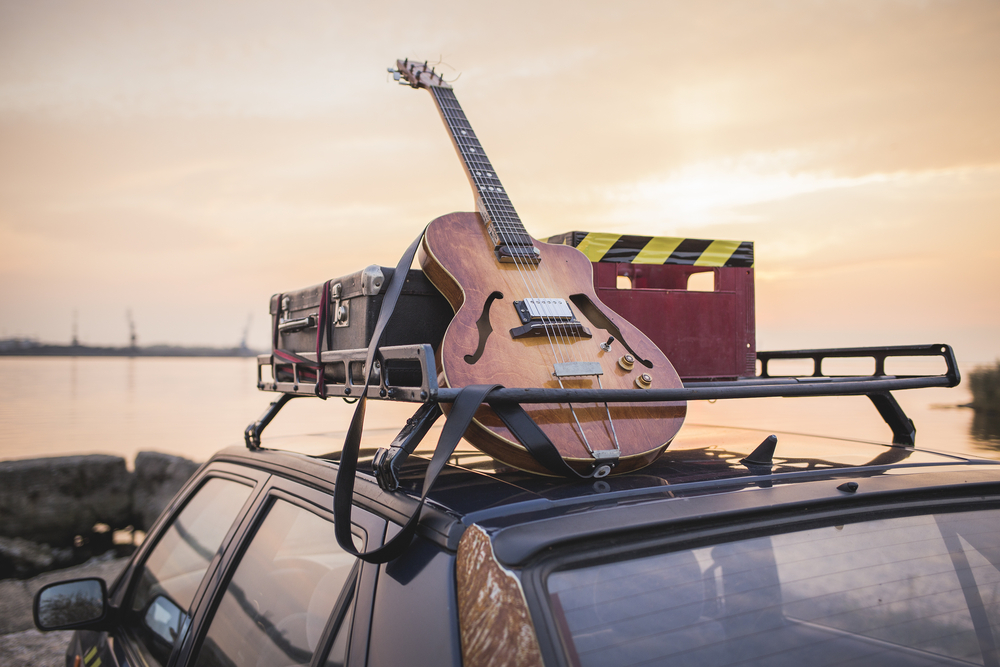
It is possible to travel with a big guitar if you don’t want to spend the money on a travel guitar. Just be aware that there are some frustrations that will come with trying to take a big instrument onto an airplane. The TSA is frustratingly vague about it, and some airlines will want you to buy a seat to stick a big guitar in.
The best thing to do is to get travel insurance, or insure the instrument, and check in the instrument using an approved flight case.
Hit the Road
… Jack. Or whatever your favorite song about traveling is, there are hundreds. I’ve Been Everywhere by Cash is a good one, and if you’d definitely attract a crowd if you whipped out your travel guitar and covered it. Wherever you go, whatever song moves you there, life is improved if you take a guitar with you. Grab one and get out there.

